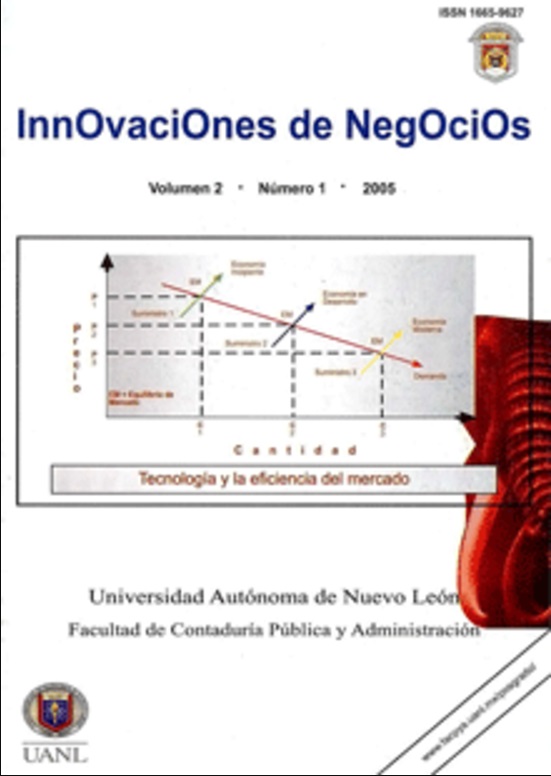A review of the strategic management process, study of the strategy, structure and equifinality paradigm: an empirical research in northeast Mexico companies
DOI:
https://doi.org/10.29105/rinn2.3-4Keywords:
Chaos, Equifinality, Situational, Strategy, Structure, SystemAbstract
The objective of this research is to test empirically the strategy, structure and equifinality paradigm in northeast México companies. Businesses, in this region of the country, were studied through the application of a questionnaire. The paradigm of Chandler regarding “structure follows strategy” is the independent variable. The dependent variable is established as finding equifinal results with or without the presence of the strategy -structure paradigm. From this study, two contributions materialize. The first one is that it is effectively true the relationship between strategy and structure. The second and more important one is that the equifinality paradigm was in fact true and empirical evidence was obtained. To determine the reasons for the functioning of this paradigm, more research is needed. “No matter the beginnings”, final success may be explained by the wholistic nature of management.
Downloads
References
Ashmos, D.P. y G.P. Huber. 1987. The Systems Paradigm in Organization Theory: Correcting the Record and Suggesting the Future. Academy of Management Review. 12: 607-621.
Bettis, R. A., y C. K. Prahalad. 1995. The dominant logic: Retrospective and Extension. Strategic Management Journal. 16: 5-14.
Burns, J. S. 2002. Chaos theory and leadership studies: Exploring uncharted seas. Journal of Leadership & Organizational Studies. Flint Fall. 9(I2): 42.
Burns, T. y G. M. Stalker. 1961. The Management of Innovation. London. Tavistock Publications.
Certo, S.C. 2001. Administración Moderna, 8a. ed. Bogotá, Colombia: Pearson Educación de Colombia Ltda.
Chandler, A.D., Jr. 1962. Strategy and Structure. Cambridge, M.A. MIT Press.
Chennai, B. 2003. Of Chaos and Complexity. Businessline: 1.
DeGrauwe, P., H. Dewatcher y M. Embrects. 1993. Exchange rate theory: chaotic models of foreign exchange markets. Blackwell, Oxford, UK.
Deshpande, R. y J.U. Farley. 1998. Measuring Market Orientation: A Generalization and Synthesis. Journal of Market Focused Management 2: 213-232.
Dessler, G. 1979. Organización y Administración: Un Enfoque Situacional. Cali, Colombia. Prentice-Hall International.
Dill, W.R. 1958. Environment as an Influence on Managerial Autonomy. Administrative Science Quarterly 2: 409-443.
Doty, D.H., W.H. Glick y G.P. Huber. 1993. Fit, Equifinality, and Organizational Effectiveness: A Test of Two Configurational Theories. Academy of Management Journal 36: 1196-1250.
Drago, A.W., 1998. Mintzberg’s Pentagon and Organisation Positioning. Management Research News 21(4/5): 30.
Galbraith, J.R. 1973. Designing Complex Organizations. Reading, M.A. Addison-Wesley.
Gleick, J. 1987. Chaos Making a New Science. N.Y. Penguin Books.
Gutiérrez, S. R. 1992. Introducción a la Filosofía. México: Editorial Esfinge, S.A. de C.V.
Gresov, C. y R. Drazin. 1997. Equifinality: Functional Equivalence in Organizational Design. Academy of Management Review. 22: 403-438.
Gurpreet, D. yJ. Ward. 2002. Chaos Theory as a Framework for Studying Information Systems. Information Resources Management Journal. 15(2): 5-9 .
Hrebeniak, L., y W. Joyce. 1985. Organizational Adaptation: Strategic Choice and Environmental Determinism. Administrative Science Quarterly. 30: 336-349.
Hopkins, T. 1937. Integration: Its Meaning and Application. N. Y. Appleton-Century-Crofts.
Jennings, D.F. y S.L. Seaman. 1994. "High and Low Levels of Organizational Adaptation: An Empirical Analysis of Strategy, Structure, and Performance." Strategic Management Journal 15: 459-475.
Johnson, G. y K. Scholes. 2001. Dirección Estratégica, 5a. Ed. Madrid, España: Pearson Educación S.A.
Katz, D. y R.L. Kahn. 1966. The Social Psychology of Organizations. N.Y. John Wiley & Sons.
_______ 1978. The Social Psychology of Organizations. N.Y: John Wiley & Sons.
Kauffman, S. 1995. Laws of Self Organization. Oxford: Oxford University Press.
Lawrence, P.R. y J.W. Lorsch. 1969. Organizations and Environments. Homewood, IL: Richard D. Irwin.
Lorsch, J.W. y J.J. Morse. 1974. Organizations and Their Members: A Contingency Approach. N.Y. Harper and Row.
Matsuno, K. y J.T. Mentzer. 2000. The Effects of Strategic Type on the Market OrientationPerformance Relationship. Journal of Marketing. 64: 1-16.
Meyer, A. D., A. S. Tsui y C. R. Hinings. 1993. Configurational Approaches to Organizational Analysis. Academy of Management Journal. 36: 1175-1195.
Miles, R.E. y C.C. Snow. 1978. Organizational Strategy, Structure and Process. N.Y. McGraw-Hill.
_____, _____, A.D. Meyer y H.J. Coleman Jr. 1978. Organizational Strategy, Structure, and Process. Academy of Management Review 12: 607-621.
Miller, D. 1987. The genesis of configuration. Journal of Management Studies. 12: 686-701.
Mintzberg, H. T. 1979. The Structuring of Organizations. Englewood Cliffs, N.J. PrenticeHall.
_____ 1993. Structure in Fives: Designing Effective Organizations, 2nd Ed., Prentice-Hall. Englewood Cliffs, N.J.
Nadler, D. A., y M. L. Tushman. 1988. Strategic Organization Design. Glenwood, I.L. Scott.
Peters, E. 1991. Chaos And Order in Capital Markets. New York: John Wiley & Sons.
Porter, M.E. 1980. Competitive Strategy. N.Y. Free Press.
Prichett, P. y R. Pound. 2001. The Stress of Organizational Change. Piano, Texas: Pritchett Rummler-Brache.
Pugh, D.S., D.J. Hickson, C.R. Hinnings y C. Turner. 1969. The Context of Organizational Structures. Administrative Science Quarterly. 14: 91-114.
Radzicki, M. J. 1990. Institutional Dynamics, Deterministic Chaos, and Self-organizing Systems. Journal of Economic Issues. 24,1,57-102.
Scott, W. R. 1992. Organizations: Rational, Natural, and Open Systems, 3rd Ed. Englewood Cliffs, N.J. Prentice-Hall.
Stacey, R. D. 1991. The Chaos Frontier - Creative Strategic Control for Business, Butterworth-Heinemann, Oxford.
Stoner, J. A., F. R. E. Freeman y D. R. Gilbert, Jr. 1996. Administración. Prentice Hall Hispanoamericana, S. A.
Van de Ven, A.H. y R. Drazin. 1985. The Concept of Fit in Contingency Theory. Research in Organizational Behavior, Eds B.M. Staw and L.L. Cummings. Greenwich, C.T. JAI Press: 333-375.
Venkatraman, N. y J. E. Prescott. 1990. Environment-structure Coalignment: An Empirical Test of its Performance Implications. Strategic Management Journal. 11: 1-23.
Von Bertalanffy, L. 1930. Kritische Theorie der Formbildung. Vienna. Schaltz Publishing.
_____. 1960. General Systems Theory. New York, N.Y. George Braziller.
_____. 1968. General System Theory. New Cork, N.Y. Braziller.
Wechsler, J. 1998. Managed Care Firms are Kicking Butts. Managed Healthcare 8(4): 32-36.
www.cyberspace.com/~building/ofc_21clidhock.html Hock, D.W.
(1996), The Chaordic Organization: out of Control and Into Order.
http://www.deguate.com/infocentros/gerencia/glosario/a.htm
http://www.uned.es/master-seguros/consultas/consultas_2003-04.htm
Downloads
Published
How to Cite
Issue
Section
License
Copyright (c) 2017 Innovaciones de Negocios

This work is licensed under a Creative Commons Attribution-NonCommercial-ShareAlike 4.0 International License.
The InnOvaciOnes de NegOciOs magazine is a free and open access electronic magazine of a scientific-academic nature and is a publication of the Autonomous University of Nuevo León, in which the authors retain their copyright and grant the magazine the exclusive right to first publication of the work. Third parties are allowed to use the published content, as long as the authorship of the work is acknowledged and the first publication in this journal is cited.
For more information, please contact the Research Secretary (FACPyA) of the Autonomous University of Nuevo León. Telephone: (81) 1340-4430. Email: revinnova@uanl.mx










